Does your spouse or partner have a charming habit of sending you a shopping list when you’re in the middle of something? The last time I got a list of pills, I thought, “There’s gotta be an on-demand app for this.” And you know what? Since then, my family has been shopping for medications exclusively through mobile apps, and I couldn’t be happier.
If you firmly believe in on-demand mobile software and want to learn how to make a pharmacy app that would make your customers happy, keep reading. We’ll cover the basics and share some insights.
Top Takeaways:
- Leveraging an online pharmacy app development solution can significantly enhance pharma distribution and foster growth for pharmacy stores. By adopting digital strategies, pharmacy chains can tap into the vast potential of the e-pharmacy market, providing customers with a seamless and convenient shopping experience. Pharmacy app developers play a crucial role in this transformation – they help navigate the challenges of integration, scalability, and regulatory changes while ensuring the app is easy-to-use and feature-rich.
- To develop an online pharmacy app, you will need to build two mobile apps (on iOS and Android) and a web application for managing the mobile apps. You might also consider a stand-alone application for couriers, but that’s optional.
- The key challenge to creating a pharmacy app is to get buy-in from all stakeholders because the app will need to sync/integrate with back-office operations. Otherwise, the workload on the back-office side would increase dramatically.
Table of Contents:
1. Online Pharmacy Apps Market Overview
2. Types of Pharmacy Applications
3. Benefits of Building a Pharmacy App
4. Top 3 Pharmaceutical Mobile Applications
5. Must-Have Features of an Online Pharmacy App
6. Advanced Features of a Pharma App
7. Challenges in Developing a Pharmacy App
8. 5 Steps to Make a Pharmacy App
9. Emerging Trends in Pharmacy Apps
10. How Much Does It Cost to Create a Pharmacy App
Online Pharmacy Apps Market Overview
The online pharmacy market is definitely on the rise. It grew from $50b in 2018 to $68b in 2020 and is expected to reach $178b in 2026. That’s a 250% increase.
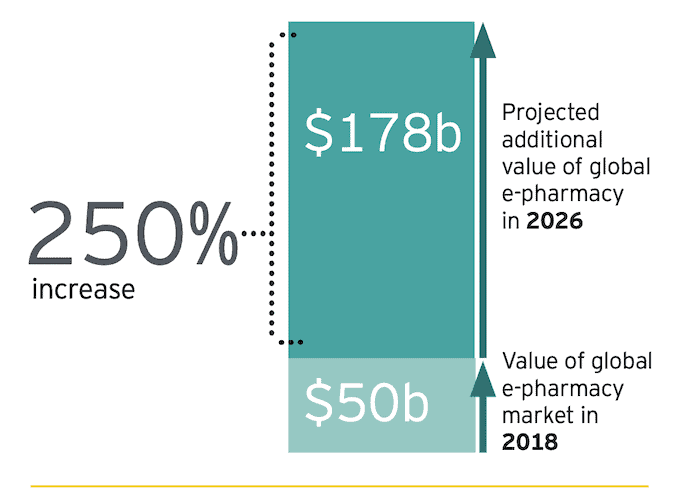
At the same time, the mHealth app market demonstrates rapid development too:
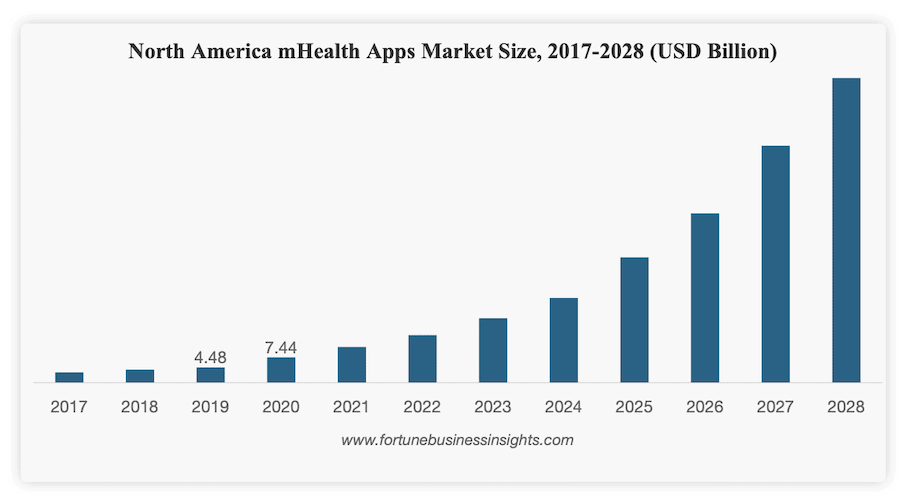 Interestingly, the epharmacy market still lags well behind in this process. According to the most recent research by Research2Guidance 2022 (Digital Health Business Outlook 2022), pharmaceutical apps (as part of digital pharmacies) are least likely to become a key trending digital health topic in 2022:
Interestingly, the epharmacy market still lags well behind in this process. According to the most recent research by Research2Guidance 2022 (Digital Health Business Outlook 2022), pharmaceutical apps (as part of digital pharmacies) are least likely to become a key trending digital health topic in 2022:
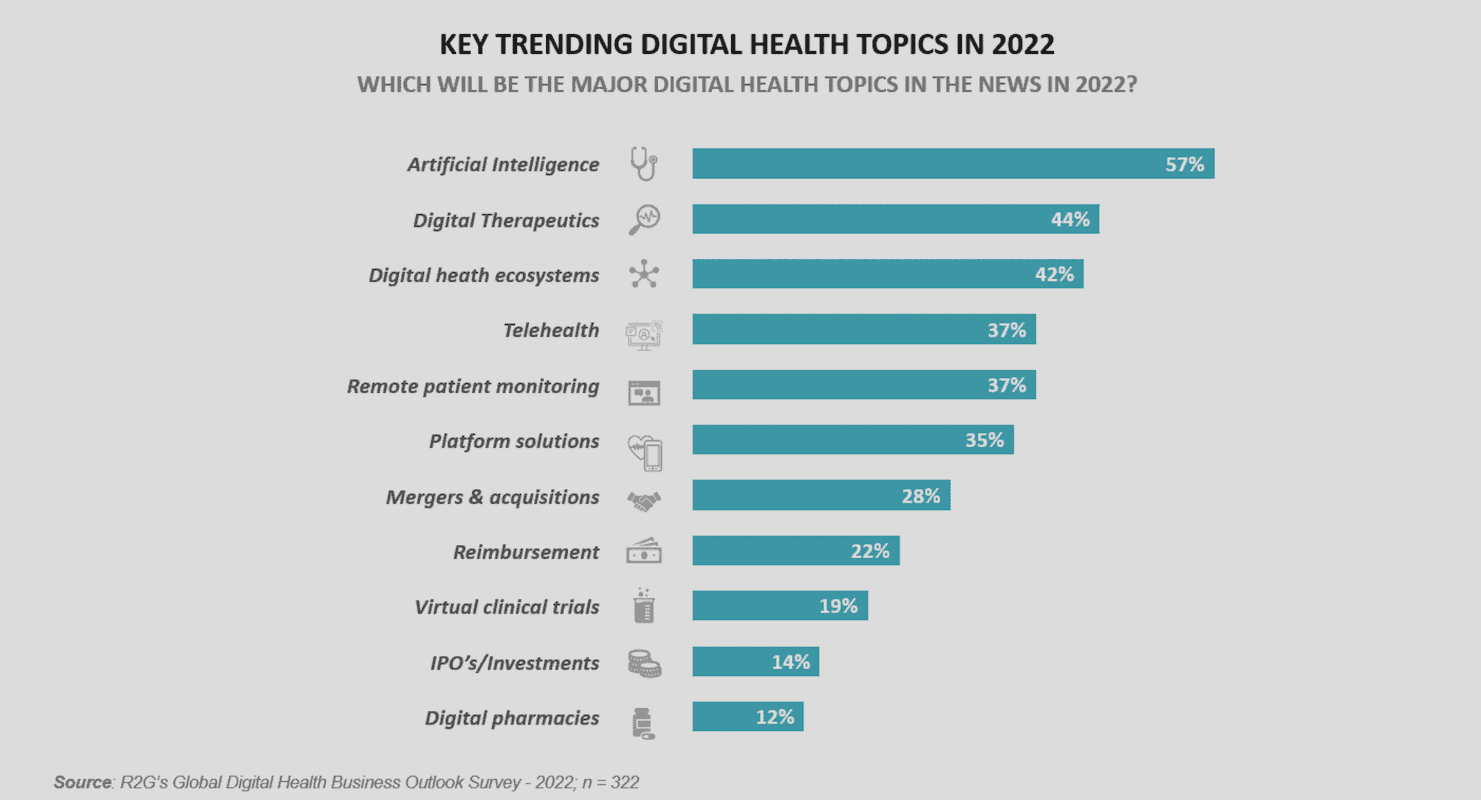
See the 12% at the bottom? I don’t know about you, but that seems like a golden opportunity for me. Simply because there’s clearly a ton of unrealized potential.
The COVID-19 pandemic has made us so accustomed to mobile shopping and on-demand contactless delivery services that we expect no less from the pharmaceutical businesses. Ernst & Young says 75% of customers expect the same level of service from health providers that they enjoy at other companies.
The global online pharmacy market, which was estimated to be $51.5 billion in 2021, is expected to exhibit a CAGR of 16% from 2023 to 2032.
Tech giants like Google and Amazon also have high hopes for pharmacy e-commerce:
- Amazon acquired PillPack (one of the leading online pharmacies) in 2018
- Google’s/Alphabet’s Wing (drone delivery) has partnered with Walgreens to launch a drone delivery service in the Dallas-Fort Worth area in April 2022
- At the same time, a survey by the National Community Pharmacists Association revealed that over 80% of adults favor their local pharmacist over mail order services. (We’ll delve into how to leverage this preference while discussing pertinent app features for pharma software app development.)
Pretty soon, pharmacies will have no option but to digitize their services by developing a pharmacy app.
Of course, it’s evident that to create your medicine delivery app, you need more than just a basic understanding of the market. I hope that this e-pharmacy app development guide can prove beneficial in your journey. However, working with professional app developers is equally, if not more, important. These experts can share best practices from their experience, ensuring your app isn’t just another addition to the app store but a game-changer in the online pharmacy industry. With their guidance, you can build an application that strikes the right balance between convenience, usability, and security, taking your pharmacy business to new heights.
Types of Pharmacy Applications
There’s not that big of a choice here. You can create a pharmacy app for your chain of pharmacies (think of it as a mobile storefront). Or you can start an aggregator app that would feature products from different pharmaceutical companies.
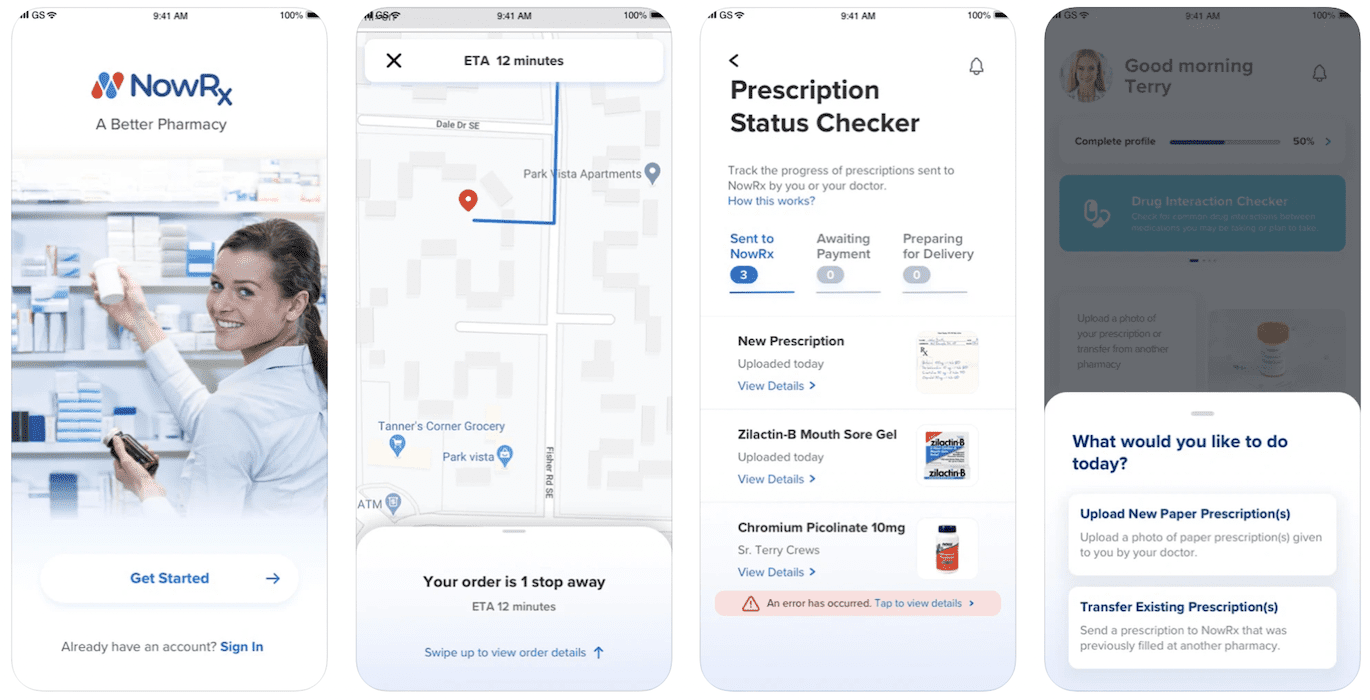 This way or another, you’ll end up with an e-commerce application where customers buy medicine because that’s the primary use case for an on-demand pharma application.
This way or another, you’ll end up with an e-commerce application where customers buy medicine because that’s the primary use case for an on-demand pharma application.
As we delve deeper into the variety of pharmacy applications, it’s essential to highlight the growing importance of online medicine delivery app development. These apps are not just about convenience; they’re about transforming the customer experience. They offer users the ability to:
- order medications with just a few clicks
- track their orders in real-time
- receive them right at their doorstep
But, while these features are impressive, they are only as good as the trust users have in the app’s handling of personal data. In this digital age, ensuring robust data security measures is paramount. It’s all about creating an app that balances convenience, personalization, and security. That might help sway the 80% of customers who prefer to shop for medications locally towards online shopping.
To be fair, I can still envision one more business model. You can partner up with a clinic and integrate their care provision services right into your pharmacy mobile app. For example, patients could hop on a video call with their doctor to get an in-app consultation on the prescribed meds. Your mobile pharmacy solution could even integrate lab tests and diagnostics.
Also Read: The Best Telemedicine Apps and How to Choose
Benefits of Building a Pharmacy App
To a casual customer, a medicine delivery app is a real boon. And not only to proverbial millennials. According to a 2020 AARP report, Americans aged 50 and older actively adopt consumer technology at rates close to those aged 18–49.
What about the benefits for pharmacies?
Increase sales
There are plenty of reasons to expect higher sales after building a pharmacy app:
- Convenience of couch-commerce (aka mobile shopping)
- Cross-selling and upselling based on user behavior
- Lower costs of running/testing marketing campaigns
- Geographic expansion across the country
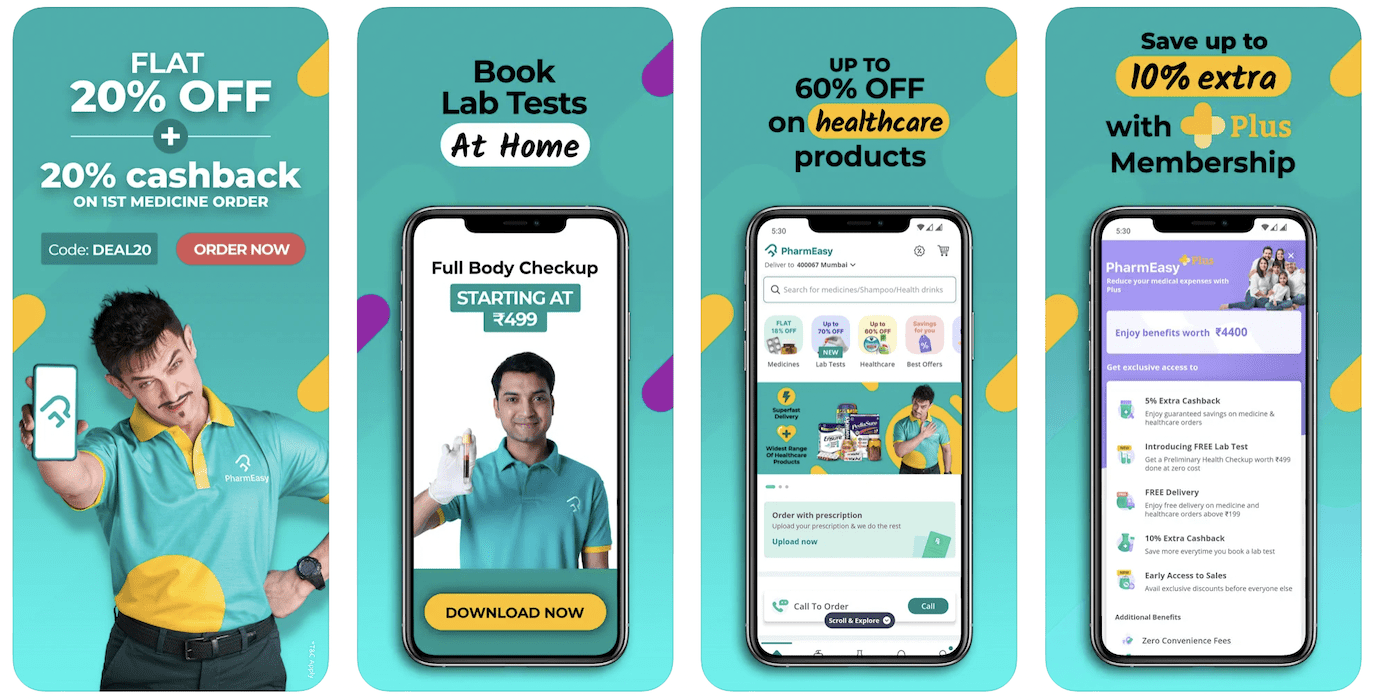
Improve customer loyalty
People love the convenience and stick with brands that bring lower prices and freedom of choice. In other words, help your customers avoid standing in lines, and they will praise you.
Lower operating costs
When everybody opts for an Uber economy, with goods and services arriving at their doorstep, can you get by with fewer resources at your brick-and-mortar locations? A pharmaceutical mobile app synced with a web portal will offer:
- full transparency into your business performance and staff productivity
- optimized internal processes, e.g., inventory management
As we wrap up our discussion on the benefits of building a pharmacy app, it’s worth noting that these advantages extend to medicine delivery software as well. When you develop a medicine delivery app, incorporating multiple payment options is just as crucial. It’s all about giving customers the freedom to choose their preferred payment method, thereby enhancing their overall experience and satisfaction. After all, in today’s fast-paced world, convenience is king!
Pharmacy apps must meet regulatory standards, and partnering with a custom mobile app development company ensures compliance and usability.
Top 3 Pharmaceutical Mobile Applications
Before you build your own pharmacy app, let’s review top pharma apps and see if we can borrow any product development ideas for our custom pharma app. Unfortunately, mobile apps from pharmaceutical companies rarely make it to the top charts, so we have to go by monthly downloads. Walgreens (500K), CVS Pharmacy (400K), and Rite Aid Pharmacy (50K) are all top performers.
The pandemic caused a significant surge in downloads for these pharma applications, and they remain popular.
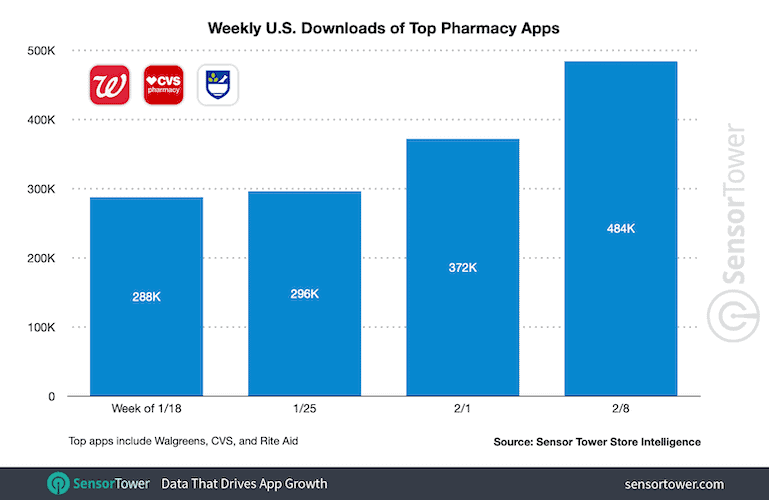
Walgreens
You couldn’t expect less from the second-largest pharmacy store chain in the U.S., right? The app allows customers to shop for meds and manage prescriptions.
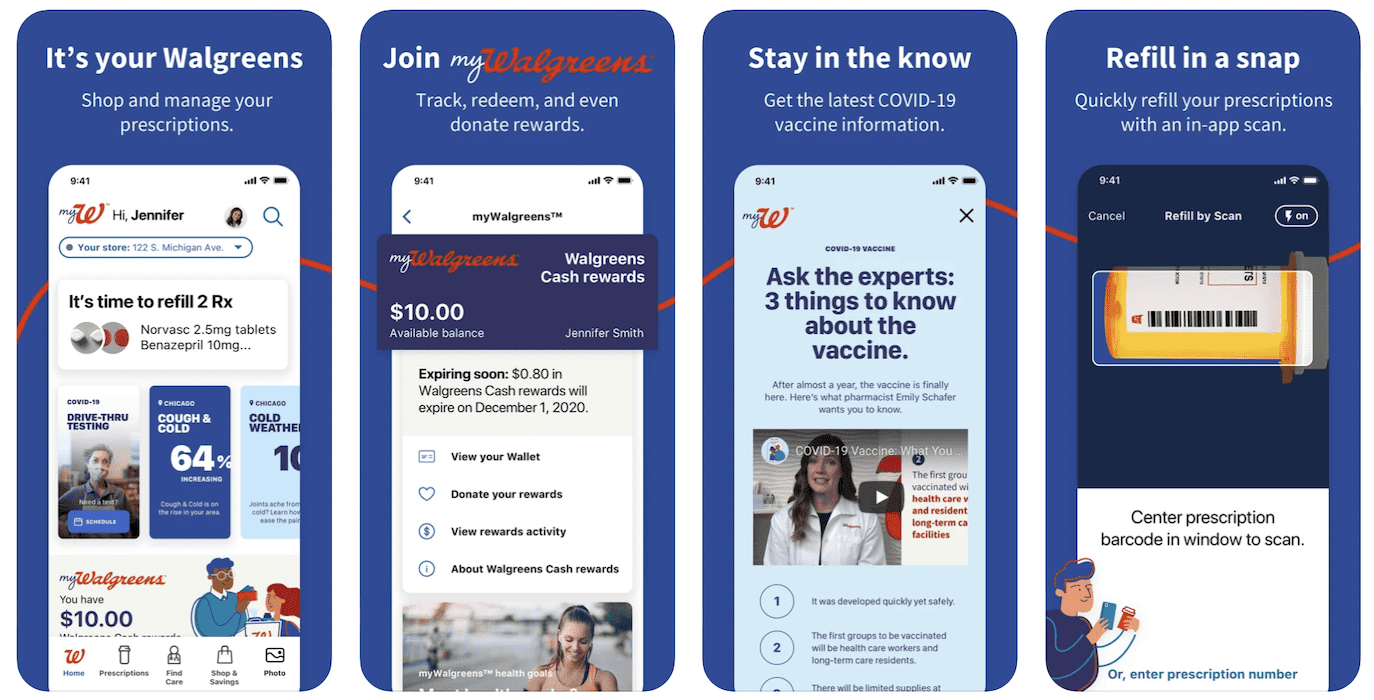
Key features (besides shopping and tracking the delivery status):
- Refill prescriptions by scanning a barcode
- Pill reminders
- Consultations with healthcare providers
- Rewards and other perks
CVS Pharmacy
CVS is an app from the #1 pharmacy chain in the U.S. And it has definitely raised the bar for on-demand mobile pharmacy software.
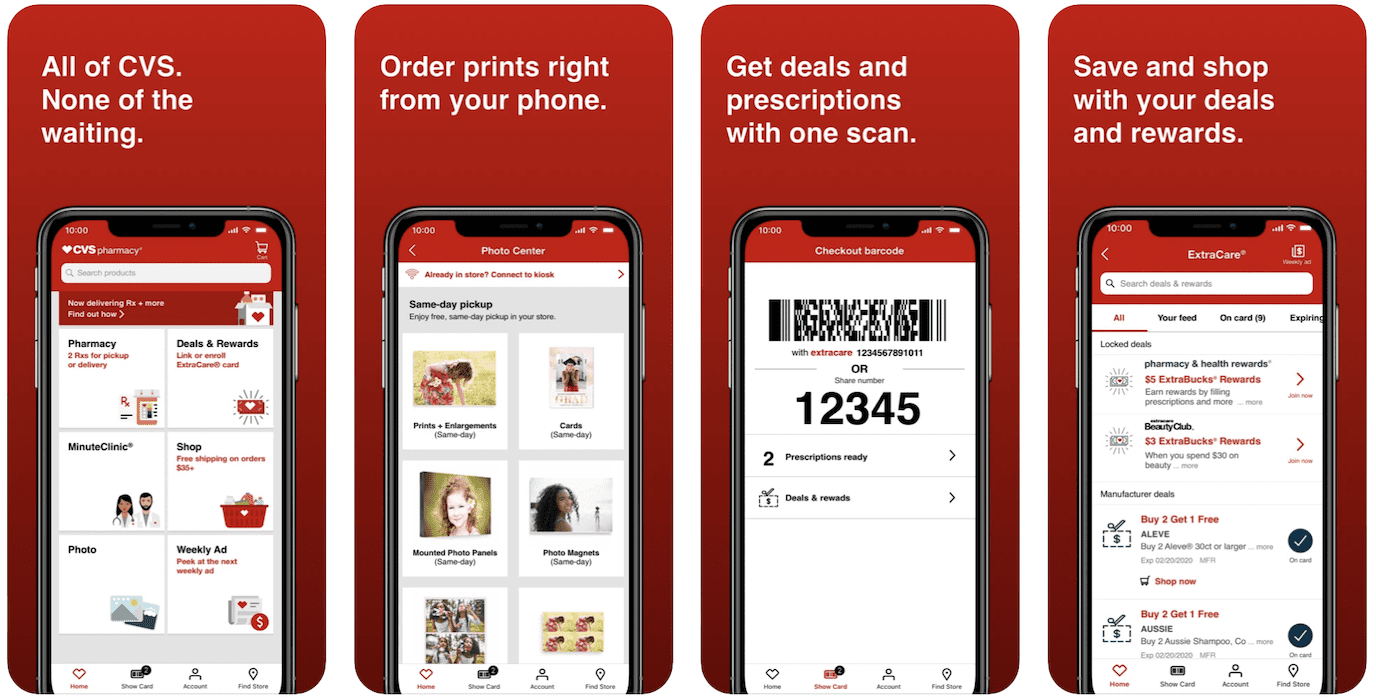 Key features:
Key features:
- Prepay for prescriptions for more private pickup
- Check drug information and interactions
- Video chat with a health care provider 24/7
- Order refills and prescription history
Rite Aid Pharmacy
Rite Aid is another well-known pharmacy network with a pharma app which has been around since 2012.
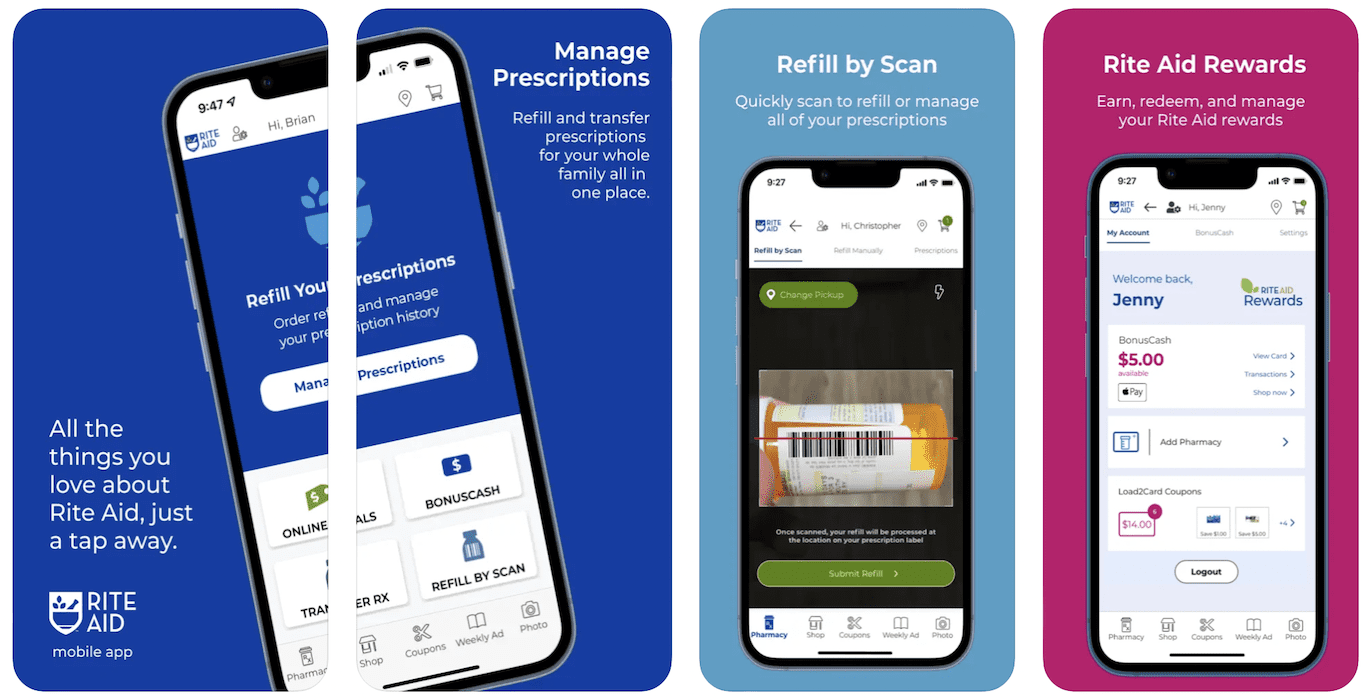 Key features:
Key features:
- prescription reminders
- manage family members’ prescriptions
- medical store locator
- track bonus points balance
I encourage you to try out these leading mobile pharmacy marketplaces for buying medicines and pharmacy delivery so that you can get a feel of their UX/UI.
As we wrap up our exploration of the top 3 pharmaceutical mobile applications, let’s not forget the potential of on-demand medicine delivery app development. The future of healthcare lies in the palms of our hands – mobile and web platforms that bring pharmacies to our doorstep. With such apps, getting necessary medicines becomes not just convenient, but also efficient and timely. Isn’t that what true healthcare innovation should be all about?
Related: UI/UX tips to designing a winning application
Must-Have Features of an Online Pharmacy App
All software has some typical features it can’t live without. What are the most common options people expect to find in a pharmacy app? Keep the following list at your fingertips as you embark on your online medicine app development journey, ensuring your software meets user expectations.
Sign-on and profile
We need an easy way to onboard new customers and store their data in the app: address, payment options, rewards balance, email address, etc. This helps us personalize their experience and ensure uninterrupted service.
E-commerce
E-commerce (or m-commerce, if you will) encompasses all features related to shopping:
- payments
- catalog of medicine
- shopping cart
- order history
- smart-search with filters and previous searches
In the rapidly evolving digital world, pharma application development has emerged as a game-changer. It’s not just about digitizing the pharmacy experience; it’s about making the process more customer-centric. A key component of this is offering multiple payment options within the app. By doing so, pharmacies can cater to a wider audience with varying preferences, truly embodying the spirit of personalized healthcare.
Prescription management
Users should be able to add their prescriptions to the app, and pharmacists will either verify them manually or with the help of AI/ML algorithms. By harnessing the power of artificial intelligence, these applications can also provide personalized medication recommendations and reminders, thereby enhancing patient adherence to their treatment plans.
Also Read: Medication Tracker and Pill Reminder Application Development
Order tracking
Consumers have really come to love tracking delivery in real-time on a map à la DoorDash and in similar delivery apps, especially after COVID-19 lock-downs.
Notifications
Push notifications and medicine reminders keep customers engaged, prompting them to take pills, order medicines, or get discounts.
Localization
Multi-language support will help you reach larger audiences. Please note that this should be addressed from the get-go because the cost of adding new languages will increase dramatically once the app is ready. Make sure to partner with the right pharmacy app development company for that.
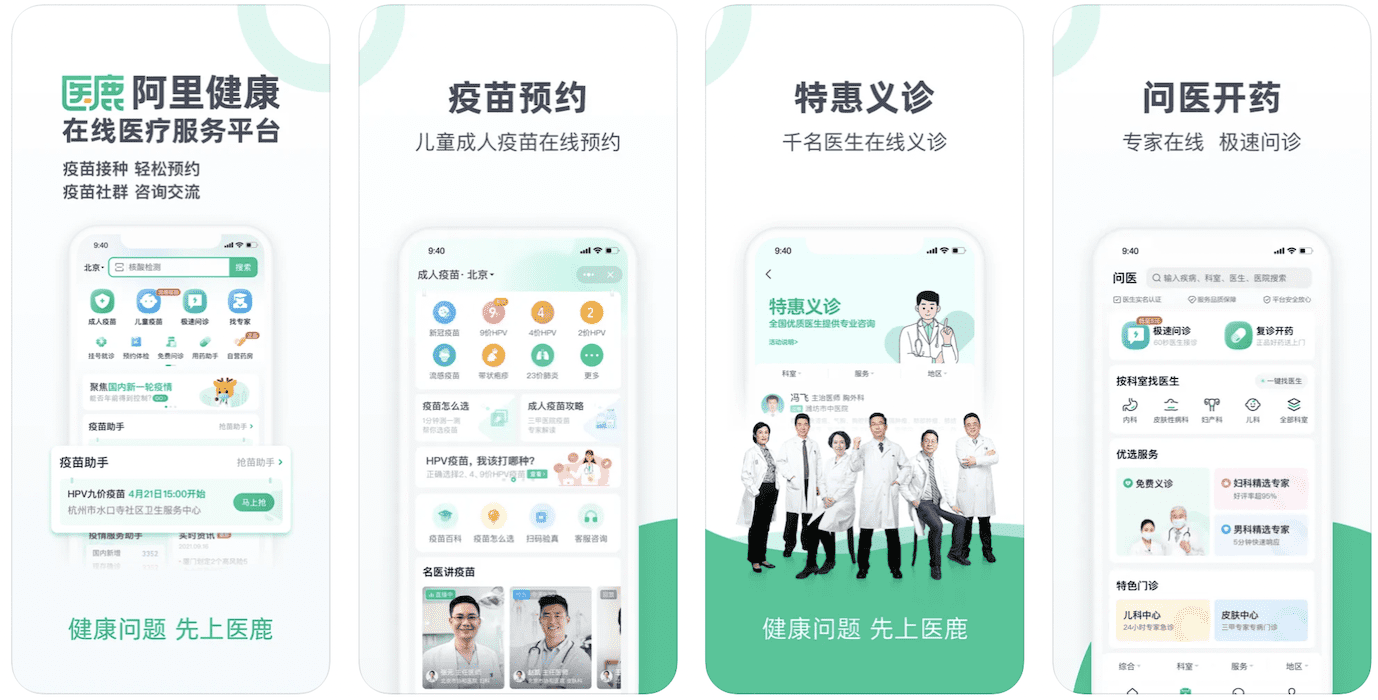
Advanced Features of a Pharma App
Now let’s review more advanced functionality that’s relevant for pharmaceutical app development. Rather than being stand-alone features, these options typically enhance usability by extending the basic functionality. For example, you can allow users to compare prices if your app aggregates meds from different chains.
Barcode scanning
This can be useful to quickly get info about prescription drugs, order a refill, or make a payment at a store.
Chat or video calls
Real-time customer support right inside the app boosts consumer confidence and makes patient assistance more accessible. In addition, you can offer telemedicine consultations with doctors or pharmacists.
Related: How to Create a Video Chat App
Pickup orders
Paying for medicine in advance and then picking it up at a store is another advanced option your customer base may appreciate.
Social interactivity
Some customers love to share their experiences with other people on social media. Therefore, allowing them to comment and review different products may prove beneficial.
Family accounts
An option to track medication adherence for senior family members and stock them up on meds from their separate apps can be a real blessing for many users.
Accessibility features
Apple and Google provide many tools for making mobile apps more accessible and inclusive. However, such an initiative goes way beyond a single option and should permeate all features.
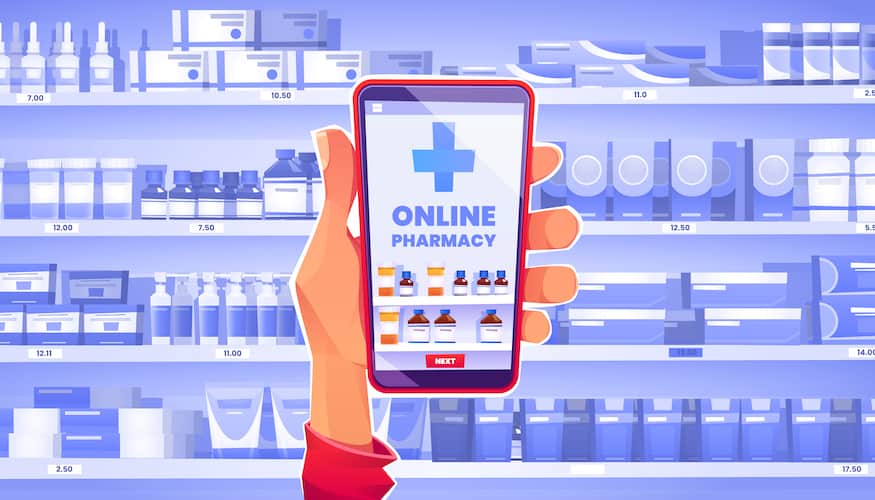
Mobile wallet
You can also set up a mobile wallet so users can up their balances and turn on automatic refills. That’s also where you integrate health insurance coverage options and rewards.
Also Read: How to make your own e-wallet for digital payments
Web portal for the business
Pharmacists and management will need a web application to manage quite a few things on their end, too:
- order management
- inventory management
- prescription verification
- EHR integration
- reports and analytics
- CMS for content management
- CRM to manage profiles
- marketing tools for running promos and ads
Access to different areas of the pharmacist panel can be restricted based on user roles.
Also Read: Heart Rate App Development Guide
As we’ve explored, the world of medicine delivery mobile app development is vast and full of potential. The incorporation of additional features can significantly enhance the user experience, making your app not just a tool, but a companion in health management.
But remember, successful implementation of these features requires professional development services. So, whether you’re considering barcode scanning, chat or video call capabilities, social interactivity, or a web portal for business, ensure you engage experts who can navigate the complexities of this domain. After all, your goal is to make healthcare more accessible, and every feature should contribute to that mission.
Challenges in Developing a Pharmacy App
Online pharmacy app development involves overcoming quite a few challenges. Here are the major factors we need to consider:
Support from all stakeholders
Everybody on the team needs to be on board with developing an online medicine app. This should include main stakeholders from sales and marketing, accounting, and other departments because it’s the only way for the software to increase efficiency on the pharmacy side.
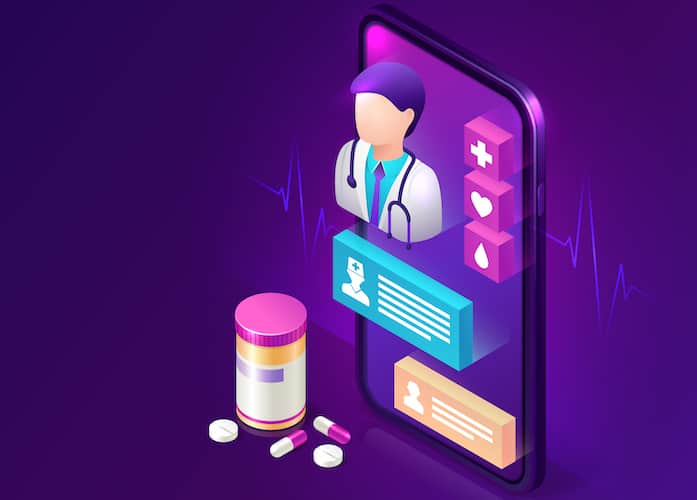
Be ready to scale from day one
The app should be architectured to guarantee smooth up-scaling. Because you can’t let the app go offline after a massive influx of customers upon release. Ideally, the app’s infrastructure should scale up or down automatically, based on the number of active users. Ask your team of experts in pharmacy delivery app development about:
- how they are going to use microservices to make the app more fail-safe
their approach to database management and optimization
The use of cloud services for flexible resource allocation, with the ability to scale resources up or down based on demand
Integration with existing e-commerce channels
Some pharmacies are likely to already have web-based e-commerce portals when they start a pharmaceutical application. Therefore, it makes sense to integrate with an existing CMS and other systems to update content in a mobile app and on the web simultaneously.
Adaptive UI
How do you design a pharmacy app that appeals equally well to baby boomers and millennials? The answer is a personalized and adaptive, user-friendly UI.
Changing regulatory environment
Regulations around data security change from time to time. And being ready to comply means having proven DevSecOps processes in place, when health data is secure during development and post-release — in customers’ hands.
In the realm of application development for pharma, it is crucial to not only be aware of these ever-evolving regulations but also to have the agility and foresight to adapt swiftly. This ensures that the app remains compliant and trusted by users, safeguarding both their health information and your company’s reputation.
5 Steps to Make a Pharmacy App
As for the software development process, online pharmacy application development is not much different from other apps. However, there are a few things to keep in mind:
- We are not just building a single mobile app
To start with, we need to cover iOS and Android to reach a wider audience. In addition, we’ll either integrate with an existing e-commerce site or build a web admin panel for physicians and managers from scratch.
- HIPAA compliance is a must
We need to comply with the HIPAA requirements during online pharmacy software development. And this applies to securing patients’ sensitive information in the apps (web and mobile) and protecting development and testing environments.
Also Read: HIPAA Compliant App Development Guide
- Keep design and development under the same roof
Over the last decade, I’ve seen too many projects fail or struggle to launch on time only because design and development were handled by separate teams.
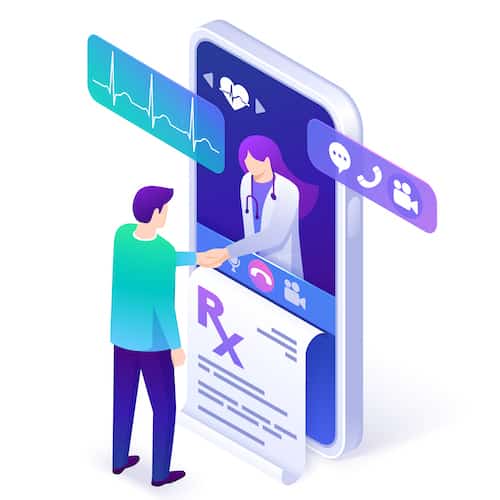
- Use recommended third-party solutions
While busy with pharma app development, we’ll work on many features that don’t need to be built from scratch. Barcode scanning, tracking locations on a map, chatting, and many other options can be implemented using verified third-party libraries.
- Follow the agile development principles
And last but not least, we need to stick with agile if we want to release in a timely fashion with an app that’s ready to generate real traction. Besides, the agile approach will be helpful as we continue to maintain the app.
Now, to the actual steps of e-pharmacy app development. These will look familiar to our regular readers:
- Step #1: Discovery – we dig deep and unearth the unique needs of your project.
- Step #2: Prototyping – our creative juices really start to flow as we bring the concept to life.
- Step #3: Development – our developers weave their code to transform the prototype into a fully-functioning app.
- Step #4: Release – We launch your innovative e-pharmacy app into the world
- Step #5: Maintenance – continually refining and updating your app to ensure it remains at the cutting edge of the industry.
Step #1: Discovery
The first step is to decide who you will target, define ROI goals, decide on the tech stack (with a qualified development team), and create a list of features.
Step #2: Prototyping
Then we visualize all options by creating an interactive prototype and sharing it with customers. Based on their feedback, we’ll perfect the UI/UX design without writing a single line of code, which means we keep our development-allocated budget safe.
Step #3: Development
Developers write code, QA engineers run tests, and DevOps engineers ensure coders and testers have a well-oiled infrastructure. We strongly advise on using a cross-platform development framework like React Native or Flutter to lower the cost of the coding phase.
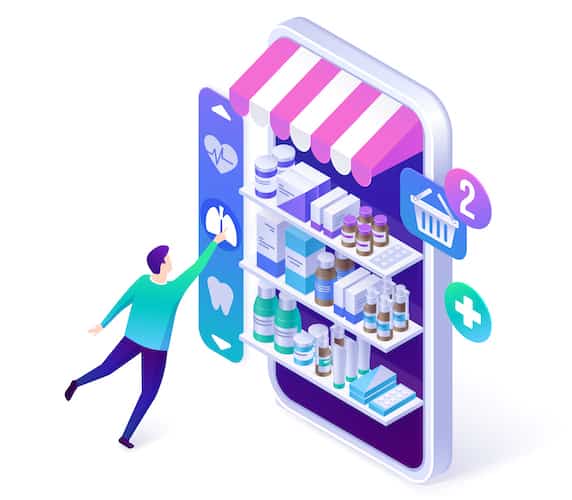
This process repeats in small increments, gradually making the apps a reality. Please note that we’ll be working on a web portal for pharmacists/admins and mobile apps at once.
Also Read: Custom Mobile App Development
Step #4: Release
Once we have a decent MVP, we can launch the app to a specified market to test how it goes. And then gradually roll out to the rest of the customers.
Also Read: MVP App Development: The Ultimate Guide
Step #5: Maintenance
Maintenance is the last step, but it loops right back to prototyping and development. Part of this phase is tracking the app’s performance for bugs and improvements, besides adding new functionality. To fix the former and implement the latter, we need to return to (sometimes) prototyping and (always) development iterations.
In the rapidly evolving world of digital healthcare, clinic pharmacy app development is not just about creating a functional app; it’s about continuously innovating, refining, and adapting to the ever-changing needs of users and the healthcare industry.
Emerging Trends in Pharmacy Apps
As we step into the future of digital healthcare, pharmacy apps are not just about delivering medications anymore. They’re becoming smarter, more intuitive, and more integrated, offering a holistic healthcare experience right at our fingertips. So, what’s driving this transformation? Let’s delve into some emerging trends you need to take into account during pharmacy mobile app development.
Harnessing the Power of Big Data
With the Internet of Things (IoT) connecting us more than ever, there’s an abundance of data waiting to be utilized. Smart pharmacy apps are leveraging this data goldmine to predict medication needs, optimize delivery routes, and even improve customer segmentation. Isn’t it fascinating how technology can turn raw data into actionable insights?
One-Stop Health Solution with Telemedicine
Imagine needing a prescription refill but having doubts about the dosage. Wouldn’t it be convenient if you could consult a doctor right then and there? That’s precisely what telemedicine integration in pharmacy apps is offering – a seamless blend of consultation and medication delivery.
AI-Powered Personalization
Ever wished your pharmacy app could understand your needs better? Well, with Artificial Intelligence (AI), that’s becoming a reality. AI algorithms analyze your past purchases and health conditions to provide personalized recommendations. It’s like having a personal pharmacist, always ready to assist you!
In essence, the future of pharmacy apps lies in smart integration and personalization, powered by IoT and AI. As we continue on this digital healthcare journey, who knows what other innovations lie around the corner? What do you think will be the next big trend in pharmacy software when you begin to create a pharmacy delivery app?
Related: Guide to Medical Large Language Models
How Much Does It Cost to Create a Pharmacy App
An MVP version would start at $120,000 and go as high as $210,000, depending on how much functionality we want to include in the shopping app and web portal.
But the investment doesn’t stop at medicine ordering app development. Post-launch maintenance and updates are equally important. Regular app updates not only fix bugs and improve performance, but also keep the app compliant with the latest regulations and user expectations.
Also Read: App Development Costs
Please schedule a call with our experts if you have an idea for a mobile pharmacy application and would like our advice on how to approach this initiative.
Related Articles:
- A Guide to Healthcare Mobile App Design
- How to Build a Doctor’s Appointment Application
- Build a Medication Reminder Application
- How to Create a Telehealth Application
- E-Prescription App Development Guide
- Virtual Nurse App Development Guide
- Women’s Health Tracking App Development
- Patient Intake Management Automation
[This blog was originally published on 1/15/2022 and has been updated for more recent content]
Both Apple and Google provide options for beta testing. For example, you can use TestFlight to invite select customers into the app and collect their feedback before going public. This will depend on your existing software setup. You may need to integrate with a present e-commerce solution, CRM, or other systems. Frankly, there are too many tech stacks to concentrate on a single one. Let a healthcare app development company make this choice. There’s hardly a variant that won’t work. Think through the nuances of each use case. Here’s an example. What happens if the customer turns off notifications? Your mobile marketing channel becomes weaker, right? Does your code verify if notifications are turned off and provide some incentives for customers to turn them back on? Can customers independently manage notifications for pill reminders and promos? There are several ways. One approach is to use a cross-platform tool, e.g., React Native or Flutter, to build iOS and pharmacy Android apps at once. After the release, you’ll be able to update both versions concurrently, spending fewer resources on maintenance. The process of building a pharmacy delivery app is like crafting a vital bridge between healthcare providers and patients. Identify the gap: What are users missing in their current healthcare experience? Could it be easy access to prescriptions or a simplified way to manage medications? Your app should aim to fill this void. Design with distinction: What sets your app apart? Is it real-time tracking, secure payments, or an intuitive prescription upload feature? Remember, a unique user experience can make all the difference. Don’t forget about compliance: When dealing with healthcare data, security isn’t a luxury, it’s a necessity. Make sure your app is compliant with regulations like HIPAA. Trust us, it’s not just about avoiding fines – it’s about gaining your users’ trust. Around 4-5 months for the first proof of concept.Frequently Asked Questions
How can I test my product with more users without adding it to the App Store?
What tech stack should I use to build a scalable pharmacy app?
How can I make my customized pharma app stand out from the competition?
How can I speed up the development of my pharma app?
Can you tell me how to build a pharmacy delivery app that stands out in the market?
How long does it take to develop a pahrmacy app?

